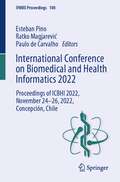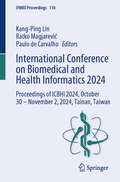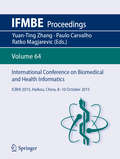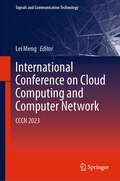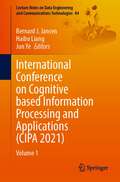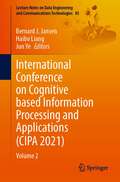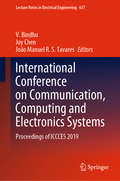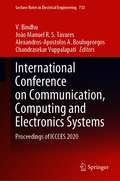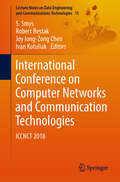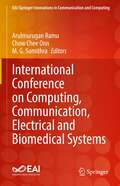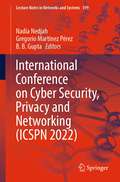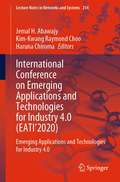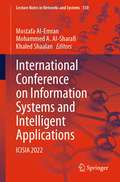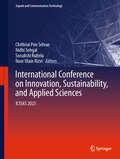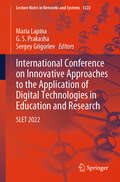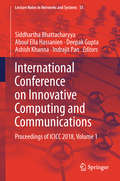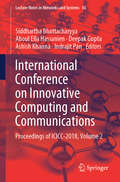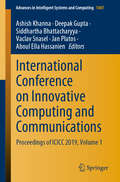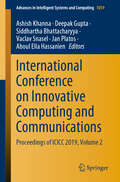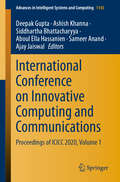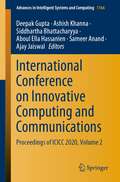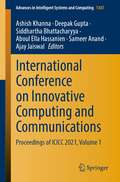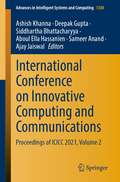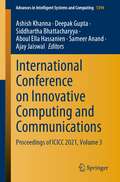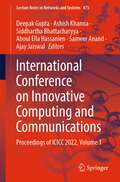- Table View
- List View
International Conference on Biomedical and Health Informatics 2022: Proceedings of ICBHI 2022, November 24–26, 2022, Concepción, Chile (IFMBE Proceedings #108)
by Ratko Magjarević Paulo De Carvalho Esteban PinoThis book covers current advances and challenges in biomedical and health informatics. It reports on the latest technologies and on strategies and concepts to implement them for medicine, health and education. Contributions deals with a range of topics, including artificial intelligence and precision medicine, e-health and training, medical devices and wearables, and medical imaging. Gathering the proceedings of the Fifth International Conference on Biomedical and Health Informatics (ICBHI 2022), held on November 24–26, 2022, in Concepción, Chile, this books provides academics and professionals with a timely snapshot of the digital transformation in the field of medicine.
International Conference on Biomedical and Health Informatics 2024: Proceedings of ICBHI 2024, October 30 – November 2, 2024, Tainan, Taiwan (IFMBE Proceedings #118)
by Ratko Magjarević Paulo De Carvalho Kang-Ping LinThis book covers current advances and challenges in biomedical and health informatics. It reports on the latest technologies and on strategies and concepts to implement them for medicine, health and education. Contributions deals with a range of topics, including artificial intelligence and precision medicine, e-health and training, medical devices and wearables, and medical imaging. Gathering the proceedings of the Sixth International Conference on Biomedical and Health Informatics (ICBHI 2024), held on October 30 - November 2, 2024, in Tainan, Taiwan, with the theme "AI Trends for Healthcare – Biomedical Data, Information Technology, and Cybersecurity", this books provides academics and professionals with a timely snapshot of the digital transformation in the field of medicine.
International Conference on Biomedical and Health Informatics: Icbhi2015, Haikou, China, 8-10 October 2015 (IFMBE Proceedings #64)
by Yuan-Ting Zhang Paulo Carvalho Ratko Magjarevic<P><P>This volume presents the proceedings of the International Conference on Biomedical and Health Informatics (ICBHI). The conference was a new special topic conference and a common initiative by the International Federation of Medical and Biological Engineering (IFMBE) and IEEE Engineering in Medicine and Biology Society (IEEE- EMBS). BHI2015 was held in Haikou, China, 8-10 October 2015. The main theme of the BHI2015 is “The Convergence: Integrating Information and Communication Technologies with Biomedicine for Global Health”. <P><P> The ICBHI2015 proceedings examine enabling technologies of sensors, devices and systems that optimize the acquisition, transmission, processing, storage, retrieval, use of biomedical and health information as well as to report novel clinical applications of health information systems and the deployment of m-Health, e-Health, u-Health, p-Health and Telemedicine.
International Conference on Cloud Computing and Computer Networks: CCCN 2023 (Signals and Communication Technology)
by Lei MengThis book covers selected and presented papers of CCCN 2023, the International Conference on Cloud Computing and Computer Network which was held in Singapore April 21-23, 2023. CCCN 2023 provides a premier forum for researchers and scholars from multiple disciplines to come together to share knowledge, discuss ideas, exchange information, and learn about cutting-edge research in diverse fields of cloud computing and computer networks. Topics covered in this book contain cloud computing and semantic web technologies, cloud applications in vertical industries, cloud computing architecture and systems, cloud computing models, simulations and designs among others. The content is relevant to academics, researchers, students, and professionals in cloud computing and computer networks.
International Conference on Cognitive based Information Processing and Applications: Volume 1 (Lecture Notes on Data Engineering and Communications Technologies #84)
by Jun Ye Bernard J. Jansen Haibo LiangThis book contains papers presented at the International Conference on Cognitive based Information Processing and Applications (CIPA) held during August 21, 2021, online conference (since COVID 19), which is divided into a 2-volume book. The papers in the first volume represent the various technological advancements in network information processing, graphics and image processing, medical care, machine learning, smart cities. It caters to postgraduate students, researchers, and practitioners specializing and working in the area of cognitive-inspired computing and information processing.
International Conference on Cognitive based Information Processing and Applications: Volume 2 (Lecture Notes on Data Engineering and Communications Technologies #85)
by Jun Ye Bernard J. Jansen Haibo LiangThis book contains papers presented at the International Conference on Cognitive based Information Processing and Applications (CIPA) held during August 21, 2021, online conference (since COVID 19), which is divided into a 2-volume book. The papers in the second volume represent the various technological advancements in network information processing, graphics and image processing, medical care, machine learning, smart cities. It caters to postgraduate students, researchers, and practitioners specializing and working in the area of cognitive-inspired computing and information processing.
International Conference on Communication, Computing and Electronics Systems: Proceedings of ICCCES 2019 (Lecture Notes in Electrical Engineering #637)
by João Manuel R. S. Tavares Joy Chen V. BindhuThis book includes high impact papers presented at the International Conference on Communication, Computing and Electronics Systems 2019, held at the PPG Institute of Technology, Coimbatore, India, on 15-16 November, 2019. Discussing recent trends in cloud computing, mobile computing, and advancements of electronics systems, the book covers topics such as automation, VLSI, embedded systems, integrated device technology, satellite communication, optical communication, RF communication, microwave engineering, artificial intelligence, deep learning, pattern recognition, Internet of Things, precision models, bioinformatics, and healthcare informatics.
International Conference on Communication, Computing and Electronics Systems: Proceedings of ICCCES 2020 (Lecture Notes in Electrical Engineering #733)
by João Manuel R. S. Tavares Chandrasekar Vuppalapati V. Bindhu Alexandros-Apostolos A. BoulogeorgosThis book includes high-quality papers presented at the International Conference on Communication, Computing and Electronics Systems 2020, held at the PPG Institute of Technology, Coimbatore, India, on 21–22 October 2020. The book covers topics such as automation, VLSI, embedded systems, integrated device technology, satellite communication, optical communication, RF communication, microwave engineering, artificial intelligence, deep learning, pattern recognition, Internet of Things, precision models, bioinformatics, and healthcare informatics.
International Conference on Computer Networks and Communication Technologies: Iccnct 2018 (Lecture Notes on Data Engineering and Communications Technologies #15)
by S. Smys Robert Bestak Joy Iong-Zong Chen Ivan KotuliakThe book features research papers presented at the International Conference on Computer Networks and Inventive Communication Technologies (ICCNCT 2018), offering significant contributions from researchers and practitioners in academia and industry. The topics covered include computer networks, network protocols and wireless networks, data communication technologies, and network security. Covering the main core and specialized issues in the areas of next-generation wireless network design, control, and management, as well as in the areas of protection, assurance, and trust in information security practices, these proceedings are a valuable resource, for researchers, instructors, students, scientists, engineers, managers, and industry practitioners.
International Conference on Computing, Communication, Electrical and Biomedical Systems (EAI/Springer Innovations in Communication and Computing)
by Chow Chee Onn Arulmurugan Ramu M. G. SumithraThis book presents selected papers from the International Conference on Computing, Communication, Electrical and Biomedical Systems (ICCCEBS 2021), held in March 2021 at KPR College of Engineering and Technology, Coimbatore, Tamil Nadu, India. The conference explores the interface between industry and real-time environments with newly developed techniques in computing and communications engineering. The papers describe results of conceptual, constructive, empirical, experimental, and theoretical work in areas of computing, communication, electrical, and biomedical systems. Contributors include academic scientists, researchers, industry representatives, postdoctoral fellows, and research scholars from around the world.
International Conference on Cyber Security, Privacy and Networking (Lecture Notes in Networks and Systems #599)
by Nadia Nedjah Gregorio Martínez Pérez B. B. GuptaThis book covers selected high-quality research papers presented in the International Conference on Cyber Security, Privacy and Networking (ICSPN 2022), organized during September 09–11, 2022, in Thailand in online mode. The objective of ICSPN 2022 is to provide a premier international platform for deliberations on strategies, recent trends, innovative approaches, discussions and presentations on the most recent cyber security, privacy and networking challenges and developments from the perspective of providing security awareness and its best practices for the real world. Moreover, the motivation to organize this conference is to promote research by sharing innovative ideas among all levels of the scientific community and to provide opportunities to develop creative solutions to various security, privacy and networking problems.
International Conference on Emerging Applications and Technologies for Industry 4.0: Emerging Applications and Technologies for Industry 4.0 (Lecture Notes in Networks and Systems #254)
by Jemal H. Abawajy Kim-Kwang Raymond Choo Haruna ChiromaThis book addresses the adoption of intelligent algorithms for resolving challenges in different aspects of the society such as sport, cyber-security, COVID-19 pandemic, advertising, driving, smart environment—sensors, blockchain, cloud computing, and health. In addition, the book also covers machine learning fundamentals such as feature selection. The book presents practical simulation results and different illustrations in different chapters for easy understanding of concepts and approaches. The types of contributions in the book are as follows: original research, survey, and theoretical insight that describe advancement in the adoption of technique for resolving the broad range of challenges. Researchers, undergraduates, postgraduates, and industry experts will find the book as a valuable resource that bridges theory and practice.
International Conference on Information Systems and Intelligent Applications: ICISIA 2022 (Lecture Notes in Networks and Systems #550)
by Khaled Shaalan Mostafa Al-Emran Mohammed A. Al-SharafiThis book sheds light on the fundamental and innovative topics in information systems and their societal impact on individuals and organizations. It mainly focuses on the role of artificial intelligence in organizations, human-computer interaction, IS in education and industry, and IS security, privacy, and trust. The outcomes are expected to assist the decision-makers in formulating the required policies and procedures for using cutting-edge technologies.
International Conference on Innovation, Sustainability, and Applied Sciences: ICISAS 2023 (Signals and Communication Technology)
by Chithirai Pon Selvan Nidhi Sehgal Sonakshi Ruhela Noor Ulain RizviThe book presents the proceedings of the International Conference on Innovation, Sustainability and Applied Sciences (ICISAS 2023), which took place in Dubai, UAE, on 09-11 December 2023. The conference is a unique opportunity to learn from leading researchers and professionals on how to collectively shape the future through innovation, sustainability, and scientific vigor. Topics include but are not limited to sustainable materials and manufacturing, renewable energy, cyber incident and security, information security risk management, and sustainable finance and investments, to name a few. The conference is meant to attract experts from diverse industries, including senior government leaders, policymakers, eminent scientists, academicians, researchers, technocrats, and students from various parts of the world. This multi-professional conference is dedicated to all applied specialized and interdisciplinary fields.
International Conference on Innovative Approaches to the Application of Digital Technologies in Education and Research: SLET 2022 (Lecture Notes in Networks and Systems #1222)
by G. S. Prakasha Maria Lapina Sergey GrigorievThis book is based on the best papers accepted for presentation during the SLET-2022: International Conference on Innovative Approaches to the Application of Digital Technologies in Education and Research. The book includes research on digital pedagogy, e-learning technologies, end-to-end technologies in education, and educational transformation. The contributions in this volume highlight the significant advancements and innovative methodologies in digital education. The book provides a consolidated research exploration on contemporary themes in education such as digital teaching technologies, digital pedagogy and resources, gamification, and innovations in education with a special focus on educational technology for present and future educators. The authors of these papers have explored diverse topics, such as artificial intelligence in education, the integration of virtual and augmented reality, the development of online learning platforms, and the impact of digital tools on student engagement and learning outcomes. This collection aims to provide educators, researchers, and practitioners with insights into the latest trends and challenges in digital education. It also seeks to inspire further research and innovation in applying digital technologies to enhance teaching and learning experiences. As the landscape of education continues to evolve, the integration of digital technologies becomes increasingly critical. This book addresses a wide range of issues and opportunities, offering valuable perspectives on how digital tools can be leveraged to improve educational outcomes and accessibility. This book serves as a vital resource for comprehending the future of education and the transformative role digital technologies play in its development. By delving into the innovative approaches and cutting-edge research presented within, readers gain a deeper understanding of how digital advancements are redefining educational practices and enhancing learning experiences. The insights provided in this volume help educators develop more effective teaching strategies, incorporate new technologies into their curricula, and ultimately create more engaging and inclusive learning environments. Moreover, the book intends to foster new ideas, discussions, and collaborations that will continue to advance educational technology, thus bringing together a diverse array of research and perspectives to encourage a multidisciplinary approach to solving the complex challenges facing modern education.
International Conference on Innovative Computing and Communications: Proceedings Of Icicc 2018, Volume 2 (Lecture Notes in Networks and Systems #56)
by Siddhartha Bhattacharyya Aboul Ella Hassanien Indrajit Pan Deepak Gupta Ashish KhannaThe book includes high-quality research papers presented at the International Conference on Innovative Computing and Communication (ICICC 2018), which was held at the Guru Nanak Institute of Management (GNIM), Delhi, India on 5–6 May 2018. Introducing the innovative works of scientists, professors, research scholars, students and industrial experts in the field of computing and communication, the book promotes the transformation of fundamental research into institutional and industrialized research and the conversion of applied exploration into real-time applications.
International Conference on Innovative Computing and Communications: Proceedings of ICICC 2018, Volume 2 (Lecture Notes in Networks and Systems #56)
by Siddhartha Bhattacharyya Aboul Ella Hassanien Indrajit Pan Deepak Gupta Ashish KhannaThe book includes high-quality research papers presented at the International Conference on Innovative Computing and Communication (ICICC 2018), which was held at the Guru Nanak Institute of Management (GNIM), Delhi, India on 5–6 May 2018. Introducing the innovative works of scientists, professors, research scholars, students and industrial experts in the field of computing and communication, the book promotes the transformation of fundamental research into institutional and industrialized research and the conversion of applied exploration into real-time applications.
International Conference on Innovative Computing and Communications: Proceedings of ICICC 2019, Volume 1 (Advances in Intelligent Systems and Computing #1087)
by Vaclav Snasel Siddhartha Bhattacharyya Aboul Ella Hassanien Deepak Gupta Ashish Khanna Jan PlatosThis book includes high-quality research papers presented at the Second International Conference on Innovative Computing and Communication (ICICC 2019), which is held at the VŠB - Technical University of Ostrava, Czech Republic, on 21–22 March 2019. Introducing the innovative works of scientists, professors, research scholars, students, and industrial experts in the fields of computing and communication, the book promotes the transformation of fundamental research into institutional and industrialized research and the conversion of applied exploration into real-time applications.
International Conference on Innovative Computing and Communications: Proceedings of ICICC 2019, Volume 2 (Advances in Intelligent Systems and Computing #1059)
by Vaclav Snasel Siddhartha Bhattacharyya Aboul Ella Hassanien Deepak Gupta Ashish Khanna Jan PlatosThis book gathers high-quality research papers presented at the Second International Conference on Innovative Computing and Communication (ICICC 2019), which was held at the VSB - Technical University of Ostrava, Czech Republic, on 21–22 March 2019. Highlighting innovative papers by scientists, scholars, students, and industry experts in the fields of computing and communication, the book promotes the transformation of fundamental research into institutional and industrialized research, and the translation of applied research into real-world applications.
International Conference on Innovative Computing and Communications: Proceedings of ICICC 2020, Volume 1 (Advances in Intelligent Systems and Computing #1165)
by Siddhartha Bhattacharyya Aboul Ella Hassanien Deepak Gupta Ashish Khanna Sameer Anand Ajay JaiswalThis book includes high-quality research papers presented at the Third International Conference on Innovative Computing and Communication (ICICC 2020), which is held at the Shaheed Sukhdev College of Business Studies, University of Delhi, Delhi, India, on 21–23 February, 2020. Introducing the innovative works of scientists, professors, research scholars, students and industrial experts in the field of computing and communication, the book promotes the transformation of fundamental research into institutional and industrialized research and the conversion of applied exploration into real-time applications.
International Conference on Innovative Computing and Communications: Proceedings of ICICC 2020, Volume 2 (Advances in Intelligent Systems and Computing #1166)
by Siddhartha Bhattacharyya Aboul Ella Hassanien Deepak Gupta Ashish Khanna Sameer Anand Ajay JaiswalThis book includes high-quality research papers presented at the Third International Conference on Innovative Computing and Communication (ICICC 2020), which is held at the Shaheed Sukhdev College of Business Studies, University of Delhi, Delhi, India, on 21–23 February, 2020. Introducing the innovative works of scientists, professors, research scholars, students and industrial experts in the field of computing and communication, the book promotes the transformation of fundamental research into institutional and industrialized research and the conversion of applied exploration into real-time applications.
International Conference on Innovative Computing and Communications: Proceedings of ICICC 2021, Volume 1 (Advances in Intelligent Systems and Computing #1387)
by Siddhartha Bhattacharyya Aboul Ella Hassanien Deepak Gupta Ashish Khanna Sameer Anand Ajay JaiswalThis book includes high-quality research papers presented at the Fourth International Conference on Innovative Computing and Communication (ICICC 2021), which is held at the Shaheed Sukhdev College of Business Studies, University of Delhi, Delhi, India, on February 20–21, 2021. Introducing the innovative works of scientists, professors, research scholars, students and industrial experts in the field of computing and communication, the book promotes the transformation of fundamental research into institutional and industrialized research and the conversion of applied exploration into real-time applications.
International Conference on Innovative Computing and Communications: Proceedings of ICICC 2021, Volume 2 (Advances in Intelligent Systems and Computing #1388)
by Siddhartha Bhattacharyya Aboul Ella Hassanien Deepak Gupta Ashish Khanna Sameer Anand Ajay JaiswalThis book includes high-quality research papers presented at the Fourth International Conference on Innovative Computing and Communication (ICICC 2021), which is held at the Shaheed Sukhdev College of Business Studies, University of Delhi, Delhi, India, on February 20–21, 2021. Introducing the innovative works of scientists, professors, research scholars, students and industrial experts in the field of computing and communication, the book promotes the transformation of fundamental research into institutional and industrialized research and the conversion of applied exploration into real-time applications.
International Conference on Innovative Computing and Communications: Proceedings of ICICC 2021, Volume 3 (Advances in Intelligent Systems and Computing #1394)
by Siddhartha Bhattacharyya Aboul Ella Hassanien Deepak Gupta Ashish Khanna Sameer Anand Ajay JaiswalThis book includes high-quality research papers presented at the Fourth International Conference on Innovative Computing and Communication (ICICC 2021), which is held at the Shaheed Sukhdev College of Business Studies, University of Delhi, Delhi, India, on February 20–21, 2021. Introducing the innovative works of scientists, professors, research scholars, students and industrial experts in the field of computing and communication, the book promotes the transformation of fundamental research into institutional and industrialized research and the conversion of applied exploration into real-time applications.
International Conference on Innovative Computing and Communications: Proceedings of ICICC 2022, Volume 1 (Lecture Notes in Networks and Systems #473)
by Siddhartha Bhattacharyya Aboul Ella Hassanien Deepak Gupta Ashish Khanna Sameer Anand Ajay JaiswalThis book includes high-quality research papers presented at the Fifth International Conference on Innovative Computing and Communication (ICICC 2022), which is held at the Shaheed Sukhdev College of Business Studies, University of Delhi, Delhi, India, on February 19–20, 2022. Introducing the innovative works of scientists, professors, research scholars, students and industrial experts in the field of computing and communication, the book promotes the transformation of fundamental research into institutional and industrialized research and the conversion of applied exploration into real-time applications.
